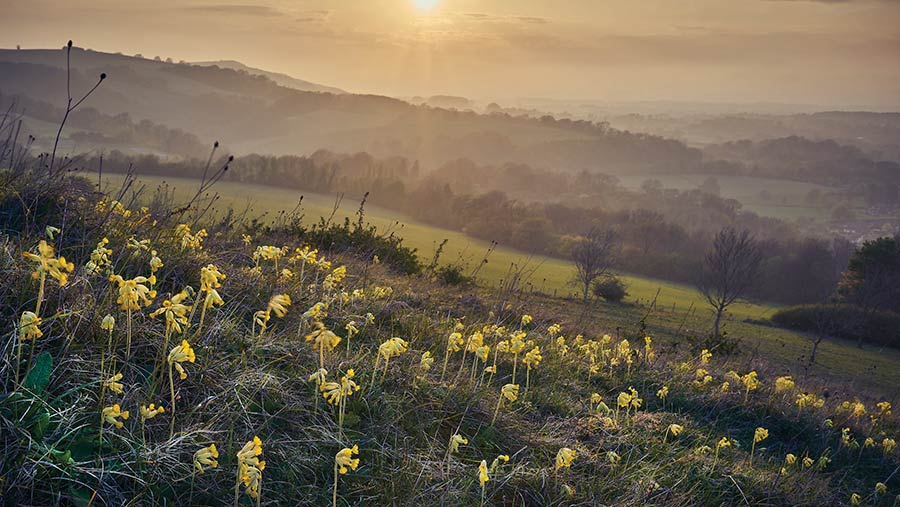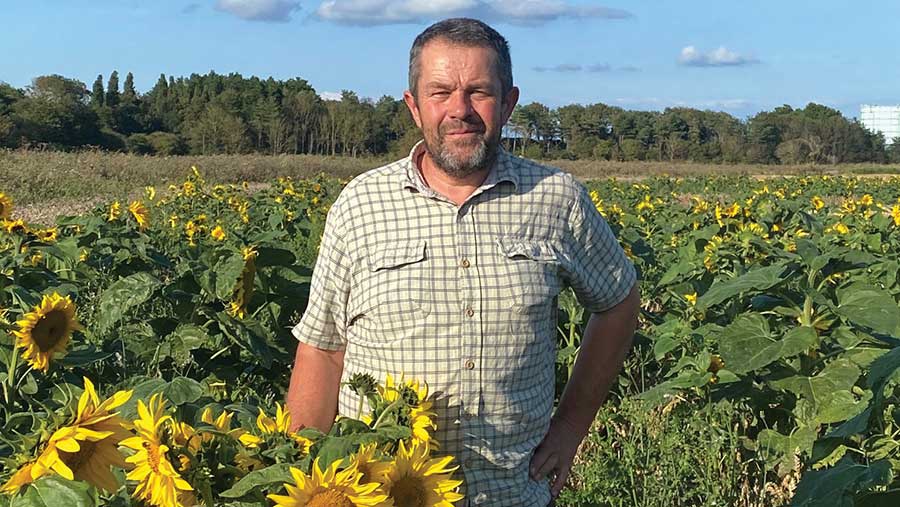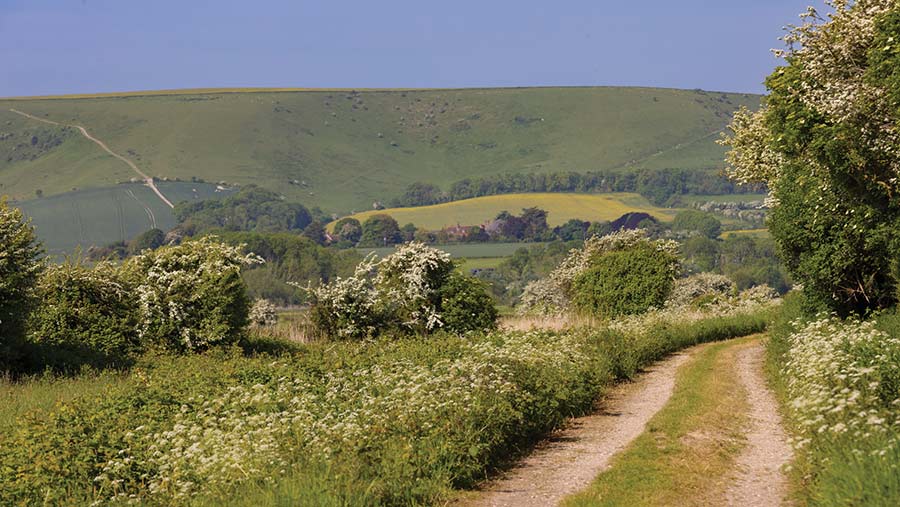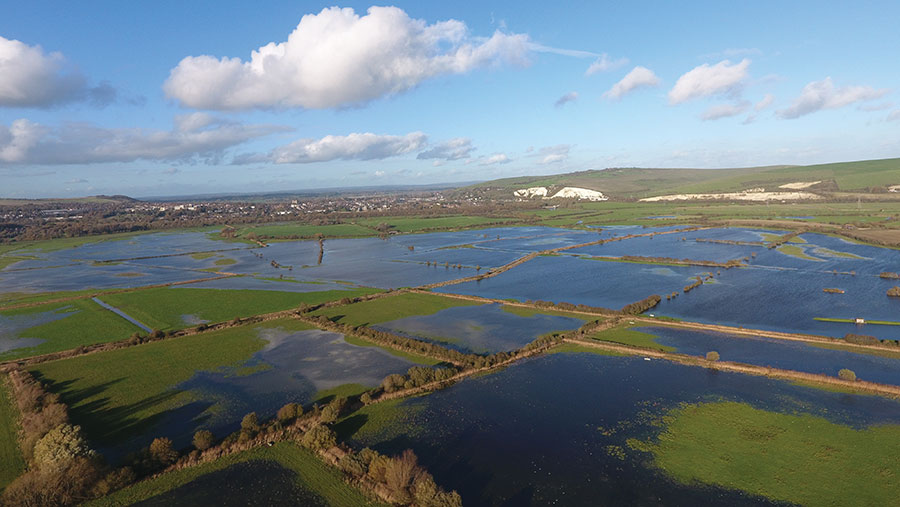How ‘mega-cluster’ project benefits farming and nature
 Wiston Estate © Matthew Thomas
Wiston Estate © Matthew Thomas A project linking farmers and private investors across a 12,500ha area of Sussex is aiming to support nature recovery and food production on a landscape scale.
The Weald to Waves (W2W) project links up farmland from the depths of the Sussex Weald to the south coast along 100-miles of three rivers – the Arun, Adur and Ouse.
The original spark for the venture came when Isabella Tree, owner of the rewilded Knepp Estate, announced a vision to create a wildlife corridor to the coast.
See also: Food production remains key on nature-friendly Suffolk arable farm
Arable grower James Baird contacted Isabella after he heard of the plans and its outlined route along the Adur to Shoreham Harbour.
James suggested Isabella’s route would be better if it followed a path through his farm, which sits on the last undeveloped stretch of West Sussex coast where the Arun flows into the sea.
James shared the views of Isabella and husband Charlie Burrell on nature recovery, having already realised that wildlife losses, soil degradation, water and air quality had left farming in an unsustainable state.
W2W project
From there, W2W was born. However, James, who is a dedicated commercial arable grower, stresses that, unlike Knepp’s approach, W2W is not a rewilding project.
Instead, he says it is a drive to produce food from profitable, sustainable farming with nature at the forefront.

James Baird © Supplied by James Baird
W2W goals
- To create a nationally significant wildlife corridor, 100 miles long, that extends to more than 20,000ha of contiguous natural habitat
- To promote nature as a provider of vital ecosystem services, backed by sustainable farming and a reduction in pollutants that compromise landscapes and water quality
- To engage people and communities by creating new opportunities to understand, enjoy and protect nature.
W2W has quickly gained traction with other like-minded farmers, and estate owners who have come to the same conclusion about prioritising nature, and routes down the Adur and Ouse were also included.
About 12,500ha has already been committed under a pledge to farm in a more sustainable way. A further 1,000ha has been identified and written into potential consortiums as part of new rounds of fund-seeking.
These emerging communities represent hard-won networks of land managers willing and able to work together to restore landscape at scale.
“Collectively, we are looking beyond the end of the Basic Payment Scheme [BPS] and at what natural assets we have that can be used to produce food more sustainably,” says James.
“Instead of depending on government support, our aim is to take control of our farming future by identifying our natural capital assets and securing independent funding streams via cross-sector partnerships.
“What we are creating is a highly investable, natural capital venture by forming a mega-cluster of clusters.”
The clusters include all scales and types of farming – from large estates to smallholdings. The venture is also open to local communities, which can pledge land or gardens to help meet the project’s goals.
This has joined up valuable wildlife habitats and engaged the communities in a positive, productive farming system.
W2W ventures
Government-backed ventures
One Landscape Recovery project, the Adur River Recovery, includes 27 farmers along the Adur corridor – although James explains not all the farmers involved are part of the W2W project.
New regional ventures include a consortium of 42 land managers across the High Weald, led by the Ashdown Forest cluster, and 17 farmers have joined forces along the Arun valley.
A fourth collaboration along the Ouse, just below Lewes, is connecting the river with the threatened chalk grasslands along the South Downs.
Strong farmer-led groups, such as the Upper Adur and Arun-to-Adur Farmer Clusters, are lead on landscape health with self-funded research into soil health, invasive species management and water quality.
Private ventures
But not all the W2W ventures are through government-led schemes. James says when farmers and growers look to income from nature, they tend to think of government initiatives such as the Sustainable Farming Incentive (SFI) scheme.
What they don’t think about, are the broader possibilities of working across the entire landscape network – farming and non-farming.
Bespoke agreements with private bidders can be forged instead. These are potentially higher value than government-backed schemes and more likely to cover lost BPS revenue.
Private deals also provide a chance to take back control from mandatory constraints and avoid the political whims of one government or the next, James points out.
To help facilitate private agreements, W2W has formed links with Network Rail, Gatwick Airport, local councils, The Highways Authority and Southern Water.
These bodies, and others like them, have turned to farmers because they realise that they cannot reverse the damaging impact on seas and wildlife without them.
One of the partners and potential investors, Southern Water, has explained to W2W members how heavy rain overloads its infrastructure, increasing pollution risks.
However, farmland can be used to hold back and control the water upstream. Millions of litres of water can be recycled, preventing pollution from ever reaching watercourses and the sea.
Pollution from soil run-off, phosphates and nitrates can also be reduced with biofilters or changes in fertiliser applications agreed with farmers.
All of this can attract targeted funding from the private company, which improves sustainable practices on-farm, provides a steady income stream and, ultimately, saves the water company money.
Unlike many government schemes, agreements with investors are also not mutually exclusive, points out James. It is possible to identify sites where agreements could be stacked to achieve multiple income streams from a single land area.
As well as the farmer and investor partners, a number of other links help group members to identify natural capital assets and adopt more sustainable farming approaches.
One such group is the Knepp Estate at Dial Post, West Sussex. Libby Drew, director of the new Knepp Wildland Foundation, plays a key role in advising James and project members on wildlife issues.
W2W has also established partnerships with bodies such as universities and expert ecologists. These can provide free or subsidised support for members, cutting the costs of potentially expensive but vital practical steps such as baselining.
Baselining is necessary because it establishes a measuring point for farm-level emissions, biodiversity, above- and below-ground carbon and the extent of fungal activity. It. also tracks seasonal populations of invertebrates and birds, explains Libby.
Ratifying these factors provides a point from which any potential improvements can be assessed and a value established and marketed to investors.
Baselining surveys highlight potential areas for new or restored habitats including biodiversity hotspots, ancient woodland, scrub, coastal marine and riverbank environments.
Without the support from W2W and its partners this process could be beyond some farm businesses.
W2W baselining
To plot and monitor the route of the project, W2W has used a combination of existing land and biodiversity data and Lidar, a remote sensing technology that uses the light from a laser to collect measurements.
This creates highly detailed 3D images of objects such as trees and hedgerows that are more accurate and revealing than satellite scans.
The resulting maps shows land contours and watercourses, highlighting areas vulnerable to run-off and erosion, and reveals historical features such as drained wetland.
For the river-linked W2W project, water quality was a major driver and soil nutrients were mapped against flows and other hydrological features.
But the mapping exercise wasn’t restricted to natural features – the project mapped roads, railway lines, construction, light pollution, housing and even areas of social deprivation.
By layering the mapping results on top of the farming map, Libby says they can identify where there are problems that farmers could help to solve.
And that is key: “We want to identify opportunities that can attract willing investors to a land area,” she adds.
For example, wildlife corridors that are disconnected by roads or rail, rivers that are vulnerable to farming or construction work run-off, or socially deprived areas that could benefit from amenity woodland.
W2W natural capital
One of the aims of W2W is to help members understand natural capital opportunities and benefit from emerging markets where demand is growing, says Molly Biddell, adviser to W2W and head of natural capital at the Knepp Estate.
Molly explains that natural capital refers to nature and the resources it provides, such as water, soil, air, wildlife and minerals.
The natural capital is the asset itself – for example, a woodland – while the phrase “ecosystem service”, is used to describe the benefits from the asset, such as carbon capture and biodiversity.
These assets have a value to society, because we depend on nature’s resources for our existence. Therefore, we need to invest in them to secure our future, she says.
Natural capital market
More companies are looking to reduce their environmental impacts, because of their own targets or environmental legislation.
Specific examples include:
- Woodland creation Selling credits for additional carbon sequestered
- Peatland restoration Credits sold for reduced carbon emissions
- Saltmarsh restoration Credits for reduced carbon emissions (coming soon)
- Hedgerow creation Credits for additional carbon sequestered (coming soon)
- Biodiversity net gain Selling units for improving habitats to generate biodiversity
- Natural flood management Selling ecosystem services to control water movement
- Wetland creation Selling nutrient reduction to developers in certain areas.
W2W plays a key role in helping to connect farmers with advisers, experts, ecologists and local case studies to help with upskilling and knowledge sharing in this fast-emerging area.
Collaboration isn’t just beneficial in terms of nature restoration, but also in increasing the opportunities for natural capital finance and markets.
The project has the benefit of bringing farmers and land managers together to deliver environmental gains at scale.
This is hugely important because emerging natural capital markets are looking to invest in large-scale projects that can deliver significant environmental returns.
W2W also helps its members to think strategically about the whole farm and broader landscape.
For example, thinking about where restoring or creating new habitats on less productive areas or where flooding could be fixed with natural management techniques.
From there, members can start to identify potential income streams for the ecosystem services they might be able to generate.
W2W’s links with potential purchasers can then help them move on to agree deals that will benefit nature and the future resilience of the farm business.
Nature and food production
Despite the focus on marketing natural assets, James says the cornerstone of the project is to maintain agricultural output.
People criticise efforts to support nature because of its perceived impact on food security. But mapping, yield and financial calculations can help to identify unproductive pockets of land on every farm.
Inputs are wasted on these unsustainable areas that have only been profitable because of the basic payments.
Land incapable of sustaining food production can be put to more lucrative uses that have the dual benefit of promoting wildlife, such as widening or planting hedgerow and targeted tree planting.
In addition, investing more in soil health to promote crop and grass growth can improve yields on the land where we do produce food, says James.
Knowledge sharing
Supporting fellow members to improve sustainable production factors through knowledge sharing is another pillar of the W2W project.
James’ 400ha arable farm supports seed pea growing for Bird’s Eye, milling wheat, oats and oilseed rape.
“We have moved to min-till, although we might have to pull the plough back out of the nettles if weeds have to be tackled in the future,” he says.
All straw is chopped, providing organic matter to improve soil health and structure. Cover cropping also boosts the soil organic matter to capture carbon and help reduce nitrogen applications and cut nitrate losses.
Any learning points are shared with other W2W members. Some areas of the farm are also used to trial innovations that could help sustain food production with less impact on nature – and the results, good and bad, are explained.
A successful trial to find alternative nitrogen sources has focused on undersowing wheat crops with microclovers. Further trials include companion cropping in oilseed rape to tackle flea beetle.
The drilled buckwheat trial has also been a success, with details passed to other farmers in the group.
Other trial work includes blending wheat varieties, so that the crop has a staggered emergence.The theory is that there is less septoria splash, cutting the dependence on fungicides and, ultimately, extending the life of a seed variety through reduced resistance, James says.
However, even though the farm is in the sunniest area of the UK, the trial failed because abnormal and relentless rainfall spanned the emergence times and septoria prevailed.
The trial is under way again to see whether a more typical year can yield the theoretical benefits.
Another trial that proved less than successful was the use of orange oil, which acts as an aphicide in the autumn. It is seven times more expensive than the chemical alternative and only works on contact, so doesn’t persist, reports James.
The field was treated three times, which ultimately proved to be 21 times more expensive than conventional controls. “If we could find a way of getting orange oil more cheaply, we could try again,” he says.
Whatever the outcome, the process of knowledge sharing across the W2W group will continue.
Case study: Richard Goring, Wiston Estate, West Sussex
The Wiston Estate, near Washington, has a history of environmental farming. In the 1960s, Prof Dick Potts set up “The Sussex Study” on the farm, which is now the longest running arable monitoring project in the world.
Then in the late 1980s, the estate was entered into the South Downs area of the environmentally sensitive area scheme.
Since 2009, the estate has planted beetle banks and conservation headlands under Higher Level Stewardship and has established wildlife corridors to connect and extend habitats.
The number of farmland birds coming back was quickly visible, reports Richard.
“Joining up with W2W gave us the chance to be part of an even wider network to get ideas and offer support by collaborating with other farmers and landowners,” he says.
Sharing ideas has helped identify where to get the most out of productive farming and where to establish corridors for nature to flow through the county, which Richard says is really important.
“Together, we are looking at how to connect up across roads and railways and, at the same time, swap notes on techniques to boost food production.
Even though we are creating new habitats and tranquil areas for wildlife to flourish away from visitors, crop yields have increased in the past 15 years. Arable output – wheat, oats and barley – is more productive than ever, even though less acreage is being used,” he says.
“We are under no illusion that we are a conventional farm and need to produce food. The rise in production has been in line with good farming practices, bringing livestock back into the rotation, clover leys and the use of cover crops.
All of which has been based on partnerships with local graziers and an excellent arable contractor.”
To target environmental ventures, the estate looked at its profit and loss sheet to identify areas that were not performing and take them out of arable production.
“Where the Basic Payment Scheme has previously plugged the gap for those areas, diminishing payments mean it no longer does.
“We looked ahead and couldn’t see that the SFI and Countryside Stewardship schemes would be able to cover loss of the BPS completely.”
Instead, the estate is looking more to its natural assets for future resilience.
“A deal with the local water company is being worked out to help lower nitrate levels in aquifers. The farm has agreed to reduce nitrogen applications and, for this, the water company is prepared to pay.
“[It] would otherwise be paying more for expensive treatment plants and chemical inputs to remove the nitrates.”
While N applications have been cut, improvements in soil health and structure through cover cropping and clover use are helping to sustain yields.
“It has also helped improve the resilience of the farm, which is now less dependent on volatile artificial nitrogen prices.”
Another venture is through a pioneering 30-year biodiversity net gain (BNG) Section 106 agreement. It will link two pieces of rich meadow land, currently separated by an arable block growing maize for a local anaerobic digester.
The 30ha meadow that will be created will be categorised as neutral grassland with a diverse mix of species under UK Habitats Classification (UKHabs).
The Section 106 has been agreed with the South Downs National Park and the estate is now actively engaging with developers and other corporates for the 215 BNG units that will be created.
We have baselined the farm with the support from W2W ecologists and they will carry out the monitoring over the 30 years of the agreement, says Richard.
To help the grassland species thrive and to get a further productivity from the land, it will be lightly grazed with cattle and sheep.
Case study: Ben Taylor, Iford Estate, East Sussex

Iford Estaten © Ben Taylor
The Iford Estate near Lewes, East Sussex, has one of the most advanced and extensive biodiversity net gain (BNG) offerings in the UK.
It joined W2W last year and, lying on the Ouse in East Sussex, added a third leg from the countryside to the coast.
The estate’s managing director, Ben Taylor, joined W2W to exchange knowledge with other farmers also on their transition journey. He says W2W has helped “put Sussex on the BNG map”.
Ben also hopes that the raised profile will help to draw farmers and investors closer together – a potential collaboration that could prove invaluable as the Basic Payment Scheme diminishes.
Iford’s work on BNG offerings began back in 2020 as part of the estate’s involvement in a Defra BNG pilot. It has since moved into the private market.
As it has developed, the estate has created more than 3,000 BNG units, which are marketed online or pitched directly at face-to-face meetings.
The units are aimed at developers across Sussex, neighbouring counties and London. They are derived from projects covering grassland, scrub, woodland, wetland and hedgerows.
Mixed scrub will be planted around margins, strategic tree planting will extend woodland and join up wildlife areas, while low-lying land will be allowed to return to wetland and control water flows.

Iford Estate © Ben Taylor
The floodplain will have extra structures, scrapes and hollows to help hold water. Some areas will be designated under UK Habitats Classification (UKHabs) as neutral grassland.
The neutral grassland area will then be grazed by cattle to add an income stream to the BNG revenue. When selecting the areas to designate for BNG credits, the estate team carried out an extensive evaluation of current and future productivity.
“We factored in climate change and other market influences to assess whether the BNG credit system will be as valuable over 30 years as, for example, a future sunflower crop or vineyard,” says Ben.
More fertile areas of the farmland have been retained for food production, but have also undergone a change in regime. “We have switched to a min-till system to improve soil biology and reduce fuel usage.”
Artificial fertiliser use has also been cut by moving to manure and other organic material. Ben says soil is their most important asset and manure helps to build organic matter.
“Yields are supported in the more fertile soils fuel and fertiliser inputs are reduced. Better soil structure and fewer cultivations also reduce erosion risks on the chalky soils, preserving it for the long-term future.”

